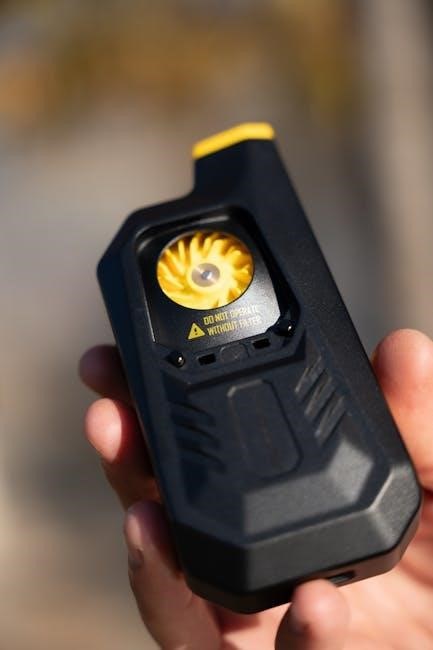orbit 57894 instruction manual
Overview of the Orbit 57894 Sprinkler Timer
The Orbit 57894 is an Easy-Set Logic indoor/outdoor sprinkler timer suitable for residential use. It can manage up to 12 zones, offering flexible watering schedules using the A, B, and C programs. The timer includes a manual mode and rain delay feature for added convenience.

Key Features and Benefits
The Orbit 57894 boasts Easy-Set Logic for simple programming. Its indoor/outdoor design allows versatile installation. Benefit from multiple programs (A, B, C) for customized watering. Manual operation provides on-demand control, while the rain delay feature conserves water automatically, pausing scheduled watering during inclement weather.
Easy-Set Logic Programming
The Orbit 57894 sprinkler timer features Easy-Set Logic, designed for straightforward and intuitive programming. This system simplifies the process of setting watering schedules, making it accessible for both novice and experienced users. The intuitive interface reduces confusion often associated with complex timer setups. The design streamlines the programming process by guiding you through each step logically.
With Easy-Set Logic, setting up watering days, start times, and run times is a breeze. The system minimizes errors and ensures your lawn receives the right amount of water at the right time. Users can quickly establish custom watering plans that address specific landscape needs. This feature also promotes water conservation.
The clear display and user-friendly buttons further enhance the Easy-Set Logic experience. Adjustments and modifications to your watering schedule can be made easily, even without consulting the manual repeatedly. This intuitive programming minimizes the learning curve. It enables users to optimize their irrigation system without frustration. The Easy-Set Logic system helps to achieve a beautifully maintained lawn.
Enjoy efficiency with the Orbit 57894’s intuitive programming. It makes scheduling simple and hassle-free. The Easy-Set Logic system ensures precise control over your irrigation.
Indoor/Outdoor Design
The Orbit 57894 sprinkler timer is engineered with a versatile indoor/outdoor design. This allows flexible installation options to suit various needs. The durable construction ensures reliable performance, whether mounted inside a garage or outside on a wall. This robust design protects the timer from the elements. It withstands rain, sun, and other environmental factors that can damage less resilient devices.
The weather-resistant casing shields the internal components from moisture and debris. This extends the timer’s lifespan and maintains its functionality over time. The protective housing is designed to prevent water ingress. This prevents electrical shorts and malfunctions. The timer’s ability to operate reliably in both indoor and outdoor settings makes it a practical choice.
The design also includes a locking cabinet with two keys. This feature enhances security, preventing unauthorized access or tampering with the settings. The swing panel display offers easy access to wiring connections. This simplifies installation and maintenance. The combination of durability, weather resistance, and security features makes the Orbit 57894 a dependable solution.
Enjoy the flexibility and peace of mind. The timer’s indoor/outdoor design ensures consistent performance. Its reliable construction guarantees long-term operation, regardless of its location. The Orbit 57894 is a dependable irrigation solution.
Multiple Programs (A, B, C)
The Orbit 57894 sprinkler timer features multiple programming options with its A, B, and C program settings. This functionality provides the flexibility to create distinct watering schedules tailored to different areas of your landscape. Each program can be customized to meet the specific needs of various plant types or zones. The A program might be set for lawns, B for flower beds, and C for vegetable gardens.
Each program allows you to set up to four different start times. This allows for cycle and soak watering. This helps to improve water absorption. Cycle and soak prevents runoff, and ensures that water penetrates deep into the soil. This promotes healthier root growth. This feature is particularly useful in areas with compacted soil or slopes. It minimizes water waste.
The timer automatically stacks overlapping runtimes from different programs. This ensures that only one zone is watered at a time; This prevents overloading the water supply and maintains consistent water pressure. The multiple programs enable you to efficiently manage watering schedules. It optimizes water usage across your entire yard.
With the Orbit 57894, you can create unique watering plans. Easily adapt to the diverse needs of your landscape. Enjoy a lush, healthy garden with minimal effort. Benefit from the flexibility and control offered by the A, B, and C programs.
Manual Operation
The Orbit 57894 sprinkler timer includes a manual operation mode. This feature allows you to override the programmed schedules. It provides on-demand watering as needed. This is particularly useful for testing zones. It’s also great for providing supplemental watering during dry spells. The manual operation gives you complete control over your irrigation system.
With the manual mode, you can choose to run a single zone. You can also run multiple zones. You can even run all zones for a specified duration. This flexibility is ideal for various situations. It’s great for addressing specific watering needs. Whether you need to test a newly installed sprinkler head or give extra water to a parched plant, the manual operation is a valuable tool.
To activate the manual mode, simply select the desired zone or zones. Then, set the watering duration. The timer will then run those zones for the specified time. This feature is easy to use. It is accessible to both novice and experienced users. The manual operation ensures that you can always provide the right amount of water. You can provide it exactly when and where it’s needed.
Enjoy the convenience and control offered by the manual operation mode. Maintain a healthy, vibrant landscape with ease.
Rain Delay Feature
The Orbit 57894 sprinkler timer includes a rain delay feature. This useful function allows you to temporarily suspend your watering schedule. This is beneficial when rainfall provides sufficient moisture. The rain delay feature helps conserve water. It prevents overwatering your lawn and garden.
When activated, the rain delay will pause all scheduled watering cycles. The pause lasts for a specified period, such as 24, 48, or 72 hours. This duration is adjustable. It allows you to customize the delay based on the amount of rainfall. After the selected delay period, the timer automatically resumes its regular watering schedule.
To activate the rain delay, simply press the designated button on the timer. Then, select the desired delay duration. The timer’s display will indicate that the rain delay is active. It will also show the remaining time before the schedule resumes. This feature is easy to use. It requires minimal effort to prevent unnecessary watering.
By utilizing the rain delay feature, you can significantly reduce water waste. You will also promote healthier plant growth. It’s an environmentally friendly way to manage your irrigation system. Embrace the rain delay feature for efficient and responsible watering practices. Take advantage of natural rainfall.

Installation Guide
Installing the Orbit 57894 sprinkler timer is a straightforward process. It ensures your irrigation system operates efficiently. First, choose a suitable location. This should be indoors or outdoors. It needs protection from direct sunlight and extreme weather. A garage or shed works well.
Next, mount the timer securely on a wall using appropriate screws. Ensure it is level. This facilitates easy access to the wiring terminals. Connect the common wire, usually white, to the designated “C” terminal. Then, attach each zone wire to its corresponding numbered station terminal. These are typically labeled 1 through 4, 6, 9, or 12, depending on your model.
For secure connections, use push-wire terminals. These allow tool-less insertion and removal of wires. The recommended wire gauge is 18. Use wire with 5 or 7 strands. After wiring, plug in the power cord. Ensure it’s connected to a reliable power source.
Finally, test each zone. This verifies proper connection and operation. Use the manual mode to activate each zone individually. Adjust any loose connections. Refer to the included manual for detailed diagrams. These provide visual guidance. Following these steps ensures a successful installation. Then you can enjoy a properly functioning sprinkler system.

Programming Instructions
Programming the Orbit 57894 sprinkler timer involves setting the date, time, and watering schedules. Begin by using the dial to select the “Set Date” option. Input the current date using the “+” and “-” buttons, then press “Enter”. Next, select “Set Time” and repeat the process. Use the buttons to set the current time of day.
To create watering schedules, choose one of the three programs: A, B, or C. Each program allows for independent settings. Select the “Program” option and choose a program. Then, set the start times. Each program supports up to four start times. This allows for cycle and soak watering.
After setting start times, specify the watering duration for each zone. Use the “+” and “-” buttons to adjust the watering time for each station. Ensure the duration matches the plant’s needs. Next, choose the watering frequency. Options include daily, weekly, or specific days of the week.
Review all settings to ensure accuracy. The “Run” position activates the programmed schedules. Use the “Manual” option for immediate watering. The “Rain Delay” feature pauses watering for a set period. This helps conserve water. Following these steps programs your Orbit 57894 timer effectively. This keeps your lawn and garden healthy.
Troubleshooting Common Issues
If your Orbit 57894 sprinkler timer isn’t working as expected, several common issues might be the cause. First, check the power supply. Ensure the timer is properly plugged into a working outlet. If using an outdoor outlet, confirm it’s weatherproof and functional. Also, inspect the transformer for any damage or loose connections. Replacing the transformer might be necessary if it’s faulty.
Another common problem is incorrect programming. Double-check the date, time, and watering schedules. Make sure the start times, watering durations, and frequencies are set correctly. Overlapping programs can sometimes cause conflicts. Review and adjust the program settings to avoid this.
If the sprinklers aren’t turning on, examine the wiring connections. Ensure the zone wires and common wire are securely connected to the terminals. Corrosion or loose wires can disrupt the signal; Clean the terminals and re-secure the wires if needed. Also, verify the valve solenoids are functioning correctly. A multimeter can help test the solenoids for continuity. Replace any faulty solenoids.
The rain sensor might also be interfering. Ensure it’s properly connected and functioning. Bypass the sensor temporarily to see if it’s the issue. Finally, consult the user manual for more specific troubleshooting steps. These steps should help resolve most common problems.

Accessing the User Manual
Obtaining the user manual for your Orbit 57894 sprinkler timer is crucial for proper installation, programming, and troubleshooting. The manual provides detailed instructions and diagrams to help you understand all the timer’s features and functions. Several avenues exist for accessing the manual.
First, check the Orbit Irrigation website. Navigate to the support section and search for the Orbit 57894 model. You should find a downloadable PDF version of the manual. This is often the quickest and most convenient method. The website may also offer other helpful resources, such as FAQs and video tutorials.
Another option is to search online using a search engine. Type “Orbit 57894 user manual PDF” into the search bar. Numerous websites may host the manual, including online retailers and user manual databases. Ensure the source is reputable to avoid downloading potentially harmful files.
If you still have the original packaging, the manual may be included as a printed document. Check inside the box or any accompanying materials. Finally, contacting Orbit’s customer support directly can help you obtain a copy of the manual. They can email you a digital version or, in some cases, mail a physical copy.
